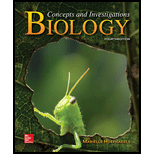
Concept explainers
A
a. sugar.
b. nitrogen-containing group.
c. sulfur-containing group.
d. phosphorus-containing group.
Introduction:
Nucleotides are defines as the organic molecules which serves as the building block of nucleic acid. It consists of phosphate group, pentose sugar and nitrogenous base. There are two types of nucleic acid such as ribonucleic acid and deoxyribonucleic acid. These are essential biomolecules responsible for forming all living forms on earth.
Answer to Problem 1MCQ
Correct answer:
The nucleotide is composed of phosphate group, pentose sugar and nitrogenous bases. Therefore, option (c) is correct.
Explanation of Solution
Reason for the correct statement
A nucleotide is organic molecule which is formed by phosphate group, pentose sugar and nitrogenous bases. There are two types of nitrogenous bases such as pyrimidine and purine bases. It also contain phosphate group. Deoxyribonucleic acid and Ribonucleic acid is formed by nucleotide. The only difference between in these two nucleic acid is presence of deoxyribose and ribose sugar as well as in RNA uracil is bonded with thymine while in DNA cytosine is bonded with thymine.
Option (c) is given as “sulfur-containing group”.
As, “Sulfur containing group is not found in nucleotide as it contains nitrogenous bases, phosphate group and sugar”, is the right answer.
Hence, option (c) is correct.
Reasons for the incorrect statements:
Option (a), is given as “sugar”.
There are two types of sugar is present in nucleotide as in RNA ribose sugar is present while in DNA deoxyribose sugar is present. Hence, it is a wrong answer.
Option (b), is given as “nitrogen-containing group”
Nitrogen-containing group are the nitrogenous bases which is of two types such as pyrimidine and purine. Hence, it is a wrong answer.
Option (d), is given as “phosphate-containing group”.
Nucleotide is formed by phosphate- sugar backbone along with that purine and pyrimidine bases are joined together by hydrogen bonds. Hence, it is a wrong answer.
Hence, options (a), (b), and (d), are incorrect.
Nucleotide is formed of sugar, phosphate group and nitrogenous bases and it do not contain sulfur containing group.
Want to see more full solutions like this?
Chapter 7 Solutions
Biology: Concepts and Investigations
Additional Science Textbook Solutions
Biological Science (6th Edition)
HUMAN ANATOMY
Campbell Essential Biology (7th Edition)
Biology: Life on Earth with Physiology (11th Edition)
SEELEY'S ANATOMY+PHYSIOLOGY
Genetics: From Genes to Genomes
- Molecular Biology Explain/discuss how “slow stop” and “quick/fast stop” mutants wereused to identify different protein involved in DNA replication in E. coli.arrow_forwardMolecular Biology Question A gene that codes for a protein was removed from a eukaryotic cell and inserted into a prokaryotic cell. Although the gene was successfully transcribed and translated, it produced a different protein than it produced in the eukaryotic cell. What is the most likely explanation?arrow_forwardMolecular Biology LIST three characteristics of origins of replicationarrow_forward
- Molecular Biology Question Please help. Thank you For E coli DNA polymerase III, give the structure and function of the b-clamp sub-complex. Describe how the structure of this sub-complex is important for it’s function.arrow_forwardMolecular Biology LIST three characteristics of DNA Polymerasesarrow_forwardMolecular Biology RNA polymerase core enzyme structure contains what subunits? To form holo enzyme, sigma factor is added to core. What is the name of the structure formed? Give the detailed structure of sigma factor and the function of eachdomain. Please help. Thank youarrow_forward
- Molecular Biology You have a single bacterial cell whose DNA is labelled with radioactiveC14. After 5 rounds of cell division, how may cells will contain radioactive DNA? Please help. Thank youarrow_forward1. Explain the structure and properties of atoms and chemical bonds (especially how they relate to DNA and proteins). Also add some pictures.arrow_forward1. In the Sentinel Cell DNA integrity is preserved through nanoscopic helicase-coordinated repair, while lipids in the membrane are fortified to resist environmental mutagens. also provide pictures for this question.arrow_forward
- Explain the structure and properties of atoms and chemical bonds (especially how they relate to DNA and proteins). Also add some pictures.arrow_forwardIn the Sentinel Cell DNA integrity is preserved through nanoscopic helicase-coordinated repair, while lipids in the membrane are fortified to resist environmental mutagens. also provide pictures for this question.arrow_forward1. Explain how genetic information is stored, copied, transferred, and expressed. Also add some pictures for this question.arrow_forward
 Concepts of BiologyBiologyISBN:9781938168116Author:Samantha Fowler, Rebecca Roush, James WisePublisher:OpenStax College
Concepts of BiologyBiologyISBN:9781938168116Author:Samantha Fowler, Rebecca Roush, James WisePublisher:OpenStax College Human Heredity: Principles and Issues (MindTap Co...BiologyISBN:9781305251052Author:Michael CummingsPublisher:Cengage Learning
Human Heredity: Principles and Issues (MindTap Co...BiologyISBN:9781305251052Author:Michael CummingsPublisher:Cengage Learning Human Biology (MindTap Course List)BiologyISBN:9781305112100Author:Cecie Starr, Beverly McMillanPublisher:Cengage Learning
Human Biology (MindTap Course List)BiologyISBN:9781305112100Author:Cecie Starr, Beverly McMillanPublisher:Cengage Learning Biology: The Dynamic Science (MindTap Course List)BiologyISBN:9781305389892Author:Peter J. Russell, Paul E. Hertz, Beverly McMillanPublisher:Cengage Learning
Biology: The Dynamic Science (MindTap Course List)BiologyISBN:9781305389892Author:Peter J. Russell, Paul E. Hertz, Beverly McMillanPublisher:Cengage Learning Biology (MindTap Course List)BiologyISBN:9781337392938Author:Eldra Solomon, Charles Martin, Diana W. Martin, Linda R. BergPublisher:Cengage Learning
Biology (MindTap Course List)BiologyISBN:9781337392938Author:Eldra Solomon, Charles Martin, Diana W. Martin, Linda R. BergPublisher:Cengage Learning Biology Today and Tomorrow without Physiology (Mi...BiologyISBN:9781305117396Author:Cecie Starr, Christine Evers, Lisa StarrPublisher:Cengage Learning
Biology Today and Tomorrow without Physiology (Mi...BiologyISBN:9781305117396Author:Cecie Starr, Christine Evers, Lisa StarrPublisher:Cengage Learning





